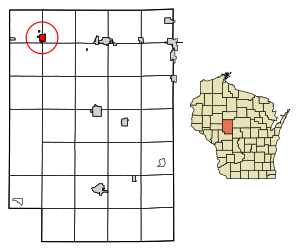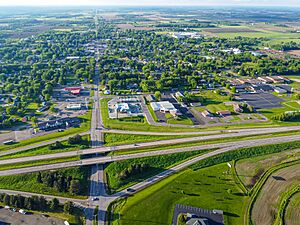Thorp, Wisconsin facts for kids
Quick facts for kids
Thorp, Wisconsin
|
|
|---|---|

Downtown Thorp
|
|

Location of Thorp in Clark County, Wisconsin.
|
|
| Country | |
| State | |
| County | Clark |
| Area | |
| • Total | 1.49 sq mi (3.87 km2) |
| • Land | 1.49 sq mi (3.87 km2) |
| • Water | 0.00 sq mi (0.00 km2) |
| Elevation | 1,214 ft (370 m) |
| Population
(2010)
|
|
| • Total | 1,621 |
| • Estimate
(2019)
|
1,611 |
| • Density | 1,079.76/sq mi (416.77/km2) |
| Time zone | UTC-6 (Central (CST)) |
| • Summer (DST) | UTC-5 (CDT) |
| Area code(s) | 715 & 534 |
| FIPS code | 55-79625 |
| GNIS feature ID | 1575404 |
Thorp is a city in Clark County, Wisconsin. It is a state in the United States. In 2010, about 1,621 people lived there. The city is partly in the Town of Thorp and partly in the Town of Withee.
Contents
Exploring Thorp's Location
Thorp is located at coordinates 44°57′35″N 90°48′3″W.
The United States Census Bureau says the city covers about 1.41 square miles (3.65 square kilometers). All of this area is land.
Thorp's Journey Through Time
Early Days and First Settlers
Before European settlers arrived, the land around Thorp belonged to the Ojibwe (Chippewa) people. In 1837, the Ojibwe gave this land to the U.S. government.
The first settler near Thorp was James Seneca Boardman. He arrived in 1870 and built a log cabin. He made money by cutting wood shingles in winter. He would haul them 50 miles to Black River Falls to sell them. His closest neighbors were ten miles away. The nearest post office was in Greenwood.
More settlers came soon after. In 1871, D.R. Goodwin and George W. Richards settled nearby. Michael McCaffrey started a home within what is now Thorp city limits. These early settlers cleared land in summer. In winter, they often worked in logging camps.
Growing the Community
In 1874, the community built its first log schoolhouse. Mrs. Almeda Edmunds was the teacher. Also in 1874, B.J. Brown opened a post office called Winnieoka. He also sold some goods to the locals. The next year, E.A. Boardman started selling supplies in what would become Thorp.
The township of Thorp was created in 1876. E.A. Boardman was chosen as chairman. The 29 voters agreed to taxes for roads, bridges, and schools. They also decided to have two school districts. A new frame schoolhouse was built that year.
In 1879, a serious illness called Diphtheria spread. Several families, including the Boardmans and Clarks, lost children.
The Railroad Arrives
In 1880, the Wisconsin Central Railroad reached Thorp. The small community had been called North Fork. But the railroad named the station Thorpe, later shortened to Thorp. The name honored Joseph G. Thorp, a state senator and founder of a lumber company.
The railroad brought more growth. L.O. Garrison opened a general store. E.A. Boardman opened a post office in his store. In 1881, the Boardmans planned a village called East Thorp. This is where the main business area is today. A hotel and a sawmill also opened. The town also had a saloon, a blacksmith, and five homes.
Community Buildings and Services
The First Baptist Church was formed in 1882. The Methodist Episcopal and St. Bernard's Catholic churches followed soon after. The first newspaper, the Pioneer, started in 1883. It later became the Courier. That same year, the school district built a second school building with four rooms.
Polish immigrants began arriving in the late 1880s. The land was cheap because much of the timber had been cut. These new arrivals worked hard on the land. Many Poles settled east of Thorp. They built their own wooden Catholic church in 1891. It was named St Hedwig's. By 1904, they built a much larger brick church. Many of these immigrants came from the area around Poznań. They also built a school called the Poznan School.
By 1894, major businesses included sawmills and a barrel-making factory.
Becoming a Village and City
In 1893, the community of Thorp voted to become a village. The population was 837. They wanted to improve order, manage animals roaming freely, and prevent fires. The next year, a water system with fire hydrants was installed. An electric light plant was added in 1901. A volunteer fire department started in 1902. A public sewer system was built in 1914.
The Thorp Telephone Company began in 1904. It started with fifty phones.
Farming and dairy production grew as logging slowed down. The Thorp Dairy Co. opened its first creamery in 1907. By 1917, it had five more in the area. Thorp Finance Co. started in 1924. A library was built in 1926.
During the Great Depression in the 1930s, a local bank closed. Many people lost their savings. Farm values dropped, and some lost their farms. However, some Polish immigrants did not trust banks, so they did not lose their savings. The expansion of Blue Moon Foods in 1939 helped the village recover.
In 1948, Thorp officially became a city. The next year, polio spread. Many activities were canceled to help stop it.
Thorp's public swimming pool was built between 1955 and 1957. It was helped by donations from Thorp Finance. Around 1960, rural schools joined together. This led to a new high school being built in 1963.
Thorp's Population Story
| Historical population | |||
|---|---|---|---|
| Census | Pop. | %± | |
| 1890 | 723 | — | |
| 1900 | 838 | 15.9% | |
| 1910 | 741 | −11.6% | |
| 1920 | 796 | 7.4% | |
| 1930 | 892 | 12.1% | |
| 1940 | 1,052 | 17.9% | |
| 1950 | 1,383 | 31.5% | |
| 1960 | 1,496 | 8.2% | |
| 1970 | 1,469 | −1.8% | |
| 1980 | 1,635 | 11.3% | |
| 1990 | 1,657 | 1.3% | |
| 2000 | 1,536 | −7.3% | |
| 2010 | 1,621 | 5.5% | |
| 2019 (est.) | 1,611 | −0.6% | |
| U.S. Decennial Census | |||
Who Lives in Thorp? (2010 Census)
In 2010, Thorp had 1,621 people. There were 712 households and 393 families. The city had about 1,149.6 people per square mile.
Most residents (98.9%) were White. About 0.6% were Native American. A small number were from other backgrounds. About 0.9% of the population was Hispanic or Latino.
About 27.7% of households had children under 18. About 39.7% were married couples. Many households (44.8%) were not families. About 39.6% of households had one person living alone. About 21.2% had someone aged 65 or older living alone. The average household had 2.19 people. The average family had 2.91 people.
The average age in the city was 41.5 years. About 24.4% of residents were under 18. About 23.2% were 65 or older. The population was 46.9% male and 53.1% female.
Learning in Thorp: Schools and Education
Students in Thorp attend schools in the School District of Thorp. There are two main schools:
- Thorp Catholic School: This school serves students from grades 1 to 8. After 8th grade, students go to Thorp High School.
- Thorp Public School: This school includes Pre-Kindergarten through 6th grade (elementary school). It also has 7th and 8th grade (junior high) and 9th through 12th grade (high school).
Famous Faces from Thorp
- Filet of Soul – a rock band from the 1960s
- Corwin C. Guell – a Wisconsin politician
- Jeff Hazuga – a former NFL (American football) player
- Stanley J. Lato – a Wisconsin politician
- Mike Maslowski – a former starting linebacker for the Kansas City Chiefs football team
- Billy Simons - a singer and song writer
- Andy North – a former professional golfer
- Eugene Oberle – a Wisconsin farmer and politician
- Arnt O. Rhea – a Wisconsin farmer, politician, and educator
- Joseph Schmittfranz – a Wisconsin politician
- John Verkuilen – a Wisconsin farmer and politician
- Robert K. Zukowski – a Wisconsin politician
See also
 In Spanish: Thorp (Wisconsin) para niños
In Spanish: Thorp (Wisconsin) para niños



